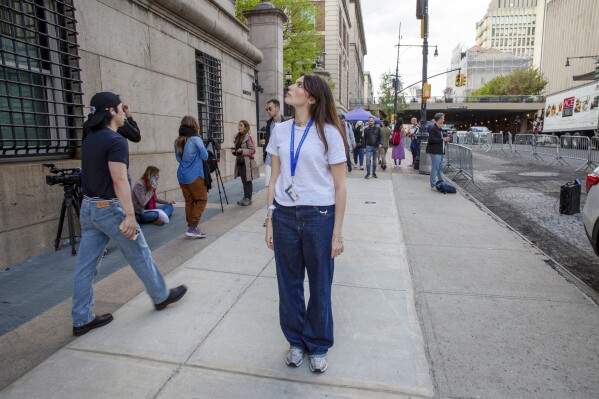Killing of 4 officers underscores risks police face when serving warrants
RALEIGH, N.C. (AP) — Arrest warrants must be served to alleged criminals if society is going to function. But there is no guarantee of safety for police officers knocking on their doors.
The grim risks came into stark relief Monday when four law enforcement officers were killed in North Carolina while serving an arrest warrant. The attack in Charlotte left four other officers wounded and became the worst attack on police in the U.S. since 2016.
The tragedy underscores the limits of even the best-trained officers and the unpredictability of the alleged criminals being served.
“A lot of these guys don’t want to go back to jail,” said Tre Pennie, executive director of the National Fallen Officer Foundation. “And if it’s not a surprise, they got time to prepare. They’re going to do everything they can to keep from going back to jail.”
Law enforcement can never control more than half of the situation, said Thor Eells, executive director of the National Tactical Officers Association.
“They can be 100% correct in everything they do,” he said, but the “suspect and or suspects are responsible for the other 50%.”



Here is what we know about the shooting in Charlotte and other fatal shootings of officers serving warrants.
WHAT HAPPENED IN CHARLOTTE?
A U.S. Marshals Task Force of officers from different agencies arrived in a residential neighborhood to try to capture Terry Clark Hughes Jr., authorities said. He was wanted for possession of a firearm by an ex-felon and fleeing to elude in Lincoln County, North Carolina.
The task force was fired on as they approached the house, and Hughes, 39, was killed in the front yard, authorities said.
An AR-15 semi-automatic rifle and a 40-caliber handgun were found at the scene. An AR-15 is able to penetrate traditional body armor and allowed the shooter to “unload several rounds towards our officers within a matter of seconds,” Charlotte-Mecklenburg Police Chief Johnny Jennings said.
He said more than 100 spent bullets were recovered, though it wasn’t clear how many were fired by the suspect. At least 12 officers also fired guns.
Authorities in Charlotte will likely conduct an “after-event analysis” that will include interviewing officers and neighbors, said Alexis Piquero, a University of Miami criminology professor.
The lessons learned will be of interest to law enforcement agencies across the country, he said, to make sure officers “can prevent this from ever happening again.”
HOW OFTEN ARE OFFICERS KILLED?
Piquero, who is a former director of the U.S. Bureau of Justice Statistics, said the serving of warrants by police often occurs as planned and runs “fairly smoothly.”
And while officers prepare for danger, shootings are unavoidable because officers can’t predict how a suspect will react. All it takes is “a high-caliber weapon (and a) person with really evil intentions,” he said.
Three officers were killed while serving warrants in 2022, according to the FBI’s Center for the Study of Law Enforcement Officers Killed and Assaulted.
Their deaths amounted 5% of the 60 law enforcement officials who died that year because of felonious incidents. Those are defined by the FBI as deaths that are the “direct result of a willful and intentional act by an offender.”
In 2021 and 2020, two officers died each year while serving an arrest warrant, FBI data shows. Five officers died in 2019 while serving search or arrest warrants.
Recent fatal shootings include the killing of two sheriff’s deputies in Cobb County, Georgia, in 2022. They were attempting to arrest a man wanted on theft charges when another man confronted them with a gun, authorities said. A shootout ensued when the armed man refused commands to drop his weapon.
In 2021, a Houston police officer was killed and another was wounded while they were attempting to arrest a man on drug charges, police said. The man they were trying to arrest was also killed.
In 2020, a Philadelphia police officer was shot and killed as he served a homicide warrant at a home, officials said. Several people were arrested, including the fugitive being sought.
HOW DO POLICE TRY TO LESSEN THE RISKS?
Eells, of the National Tactical Officers Association, said police must consider a multitude of factors before serving a warrant.
“There are so many tangibles that come to play. It’s like trying to wrap your arms around Jell-O and then pick it up,” he said. “It’s not easy.”
Among the things officers will want to know is the criminal histories of the people being arrested.
“Have they demonstrated a propensity for violence? Have they been known to carry weapons?” said Eells, who served more than 30 years with the Colorado Springs Police Department. “Are they involved in gang activity?”
Mental illness as well as drug and alcohol abuse are also valuable details. So is any formal weapons training or known access to body armor.
Then there’s the suspect’s location. Do police have to go through a fence? Is there a ring camera? Is it an apartment complex with a lot of people around? Maybe it’s safer to arrest the suspect away from home.
“They’ll go through this planning process until they arrive at a decision where they think they’ve mitigated the factors that they can control with regard to risk,” Eells said. “But there will still always be inherent risk. We cannot eliminate it.”
Disclaimer: The copyright of this article belongs to the original author. Reposting this article is solely for the purpose of information dissemination and does not constitute any investment advice. If there is any infringement, please contact us immediately. We will make corrections or deletions as necessary. Thank you.






